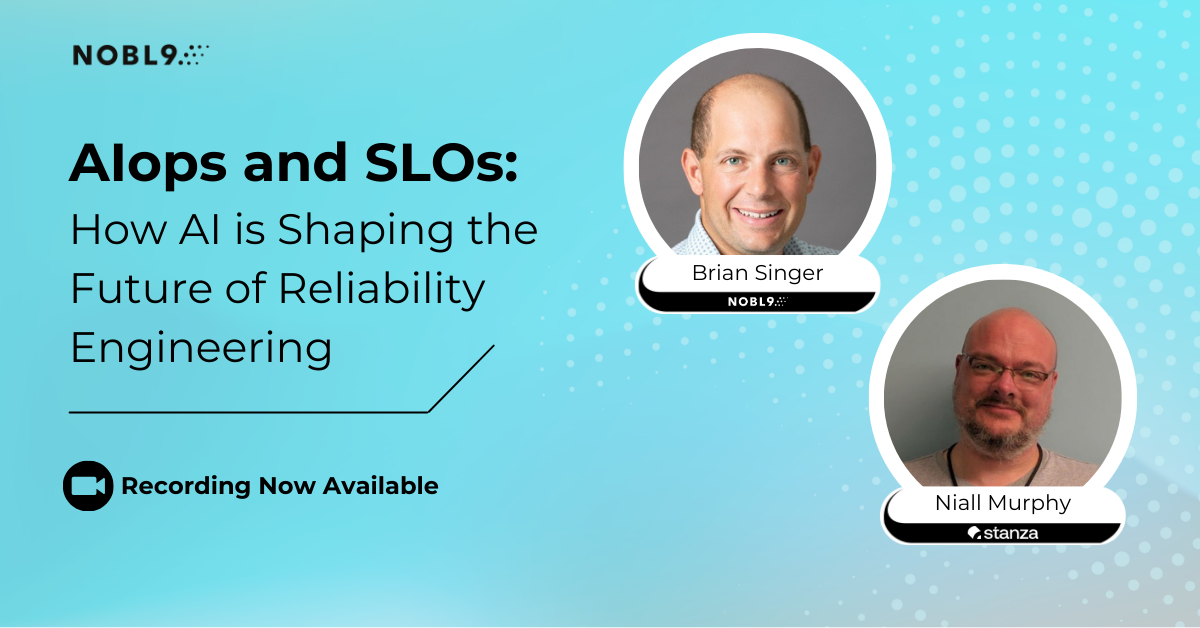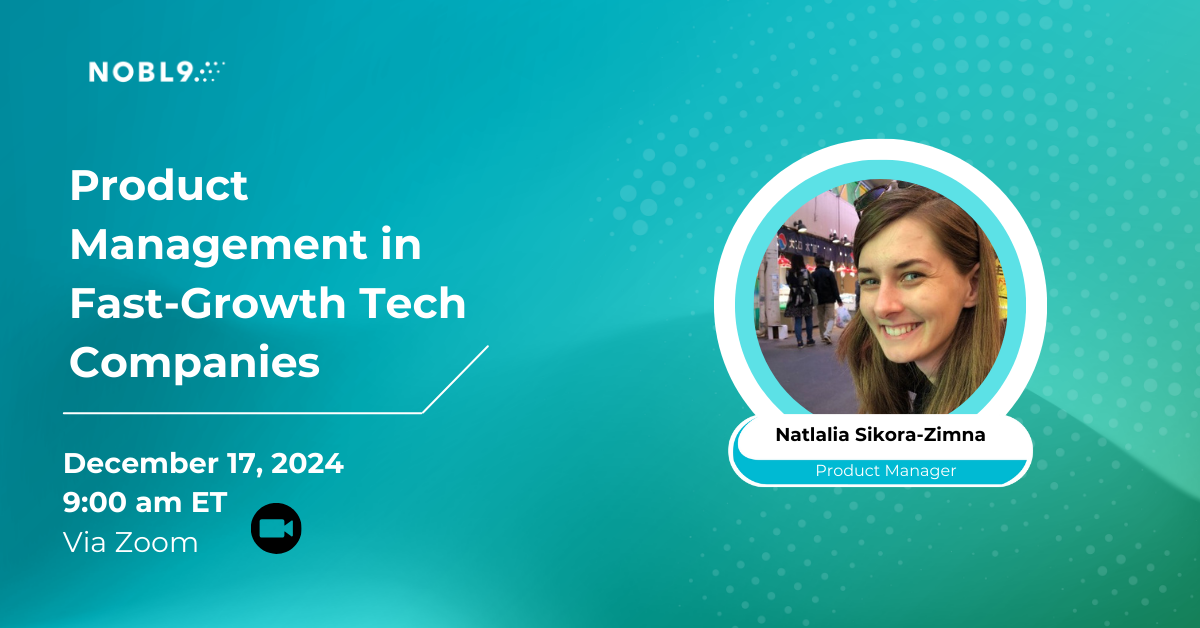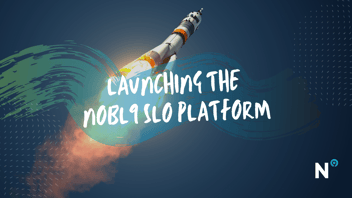More by Katarzyna Zemka:
| Author: Katarzyna Zemka
Avg. reading time: 4 minutes
The first-ever Nobl9 Hackathon emerged as an expression of the innovative future of our company, where code meets creativity and teamwork. The event served as a tribute to creative thinking, represented a fusion of ideas from different engineering backgrounds, and explored new technology territories.
Our goal for the N9 Hackathon was simple: encourage fresh thinking, collaboration, and innovative ideas. The event wasn’t just about coding; it was about exploring and understanding the perspectives of our unique set of software engineers. We had soon-to-be-released features when we finished, but the results far exceeded our expectations. Most importantly, it gave our incredible, customer-focused engineers a platform to test their ideas, explore exciting areas, and step into roles beyond their day-to-day responsibilities.
Shipping the Innovation
The hackathon's most surprising and positive outcome was that teams developed releasable features within three days. This rapid progress allowed us to introduce quality-of-life improvements and enhancements that make users' experiences smoother, starting from the Global Search. This tool empowers users to effortlessly navigate through their projects, enabling them to find specific services and SLOs in the blink of an eye. We have already shipped Default Organization, a UX improvement that lets customers select where to land after switching their organization. Next in the release queue is Backstage Plugin, which enables the display of Nobl9 SLOs on external dashboards of backstage.io. In addition, some teams introduced bulk internal improvements, from a more efficient way to track and collect product metrics to a brand-new design system that streamlines the work on new features.
Shaping the Roadmap: Proof of Concepts and New Knowledge
The hackathon resulted in tangible features and a wealth of knowledge. Participants had a chance to explore fresh ideas, break down complex problems into manageable components, and experiment with innovative solutions. One participant even wrote a white paper exploring new areas to apply SLOs. This hands-on experience allowed our teams to build a substantial knowledge base crucial to engineers while influencing future road-mapping decisions. These insights proved invaluable for our Product Organization, allowing them to prioritize and reorganize ideas by leveraging the newly acquired data.
Learning from Experience: Reflecting on our Hackathon Organization
This was our first Nobl9 Hackathon, and the journey taught us a lot about how to develop and release code, aiming to make the most significant possible impact. This is not to say that we didn’t encounter our fair share of problems throughout the period. However, these minor failures were essential to collectively using our teams' feedback to make future coding and development events operate smoothly. We also discovered that the insights we learned are applicable across teams. We're here to lend a hand if you’re considering organizing a similar event.
Team Size and Time Allocation
Because customers always come first, we considered how much time our organization could afford for the hackathon to ensure our customer commitments were unaffected. Our chosen format, a three-day coding event, proved to be an effective catalyst for innovation and collaboration. The compressed timeline encouraged participants to dig deep into their projects, fostering creative problem-solving and collaboration.
Regarding the team size, we gave participants complete freedom to form teams. Smaller teams were preferred even though we didn’t give participants rules regarding size. We found a smaller team size allowed for a more focused and collaborative approach, enabling an in-depth exploration of ideas. Additionally, it facilitated faster progress and results as teams didn't have to manage extensive organizational overhead.
Rules and Recognition
Our primary goal was to foster innovation without stifling creativity with excessive rules. Before we started, we needed to ensure all ideas were for the betterment of our product and the improvement of our user experience. We established three award categories: Best Innovation, Best Quality of Life Improvement, and Audience Choice. We invited one of our trusted customers to judge the event to add credibility.
At the end of the event, we gathered hackathon presentations, providing a platform for everyone to showcase their ideas. During this session, the panel analyzed the data to determine the winners. They evaluated various aspects of presentations, including the originality of the concept, its impact on the business and customers, the progress made in implementation, the quality of the solution, and the feasibility of integrating the idea into our product or workflows. Additionally, through shoutouts, we acknowledged outstanding ideas that didn't receive awards. This list was extensive, a testament to all the brilliant ideas presented during the hackathon.
Logistics
During the hackathon, management worked in the background to ensure optimal customer support and enable those who opted out of the event to concentrate on other tasks. Simultaneously, we aimed to foster team bonding by providing everything necessary for comfortable office use and to create a typical Hackaton vibe. Participants could stay overnight, and we supplied snacks and communal meals, enhancing the sense of community and making the experience more engaging and less burdensome. Of course, there was lots of pizza!
Lessons we Learned
To conclude the event, we asked everyone for feedback. Here are the main points we will include in organizing similar events in the future.
Several aspects received positive feedback:
- Freedom in idea exploration: Participants valued the chance to explore new ideas and work across different teams or domains, fostering a spirit of creativity. Some teams were surprised by their composition and created outstanding outcomes.
- Cross-domain collaborations: Learning from diverse perspectives encouraged collaborations, enhancing the quality of end solutions.
- Engaging presentations: Compelling presentations translated abstract ideas into tangible visions, inspiring creators and audiences.
- Atmosphere: The event's atmosphere, shared meals, informal office setup, and overnight stays created a sense of shared purpose and camaraderie.
- Focused exploration: Dedicated time for hackathon topics was allowed for innovation and focus.
Some areas would need improvement in the future:
- More straightforward guidelines: Some participants found certain aspects open to interpretation, suggesting the need for more transparent rules to prevent confusion.
- Better support for non-participants: Providing meaningful engagement opportunities for those not participating is crucial for higher inclusivity.
- Managing peer pressure: Addressing peer pressure, even in a voluntary event, ensures everyone feels free to participate or abstain.
- More freedom in choosing ideas: In the next event, we will consider broadening the scope, allowing for less product-specific ideas.
All in all, our hackathon went beyond the tech gathering. It was a recognition of our team’s innovation, creativity, teamwork, and, above all, unique culture that we’re so proud of. The achievements and lessons we gathered through this experience will guide us through similar endeavors as we look ahead. We aim to make each one a source of inspiration for our entire organization and share new insights outside of Nobl9.









.png?width=1200&height=628&name=Building%20Reliable%20E-commerce%20Experiences%20(24).png)
.png?width=1200&height=628&name=Building%20Reliable%20E-commerce%20Experiences%20(22).png)
.png?width=1200&height=628&name=Building%20Reliable%20E-commerce%20Experiences%20(19).png)









Do you want to add something? Leave a comment